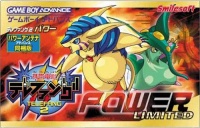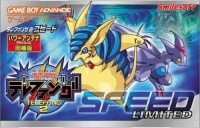Telefang 2: Difference between revisions
m (Keitai Denjū Telefang II moved to Keitai Denjū Telefang 2: Numbers are better than roman numerals) |
(removed non-encyclopaedic text, cleanup, wikify, remove explicit referral to '''you''') |
||
| Line 1: | Line 1: | ||
Keitai | {{Infobox game | ||
| japname = 携帯電獣 テレファング 二 | |||
| romaji = Keitai Denjyuu Terefangu 2 | |||
| image = [[Image:Telefang 2 Power version.jpg|200px]]<br /><br />[[Image:Telefang 2 Speed version.jpg|200px]] | |||
| developer = Smilesoft | |||
| publisher = Natsume | |||
| designer = Unknown | |||
| release-date = Unknown | |||
| genre = [[wikipedia:Console role-playing game|Console role-playing game]] | |||
| mode = Single player/Multiplayer | |||
| platform = [[wikipedia:Game Boy Advance|Game Boy Advance]] | |||
| media = Unknown}} | |||
'''Keitai Denjū Telefang 2''' is the sequel to the first Telefang game ([[Keitai Denjū Telefang 1]]) for the Game Boy Advance. Taking place in a different part of the [[Denjū]] world from the first one, this game shares some qualities with Telefang 1. The battle system is similar, as is the gathering-phone-numbers system, but a good deal of things are quite different from the original. | |||
This game was only ever released in Japanese; however, hackers | ==Plot== | ||
The game follows a blue-haired protagonist (named by the player) as he journeys on his quest to become a [[T-Fanger]]. Along the way, he encounters [[Diablos]], who is not content with humans entering the Denjū universe and so is killing off the [[Antenna tree]]s, thereby cutting off access to the human world. The player, naturally, must stop him before he is stuck in the world forever. | |||
==Differences in the two releases== | |||
There have been significant differences in the two games, Telefang 1 and 2. | |||
* The sprites were redrawn | |||
* The background musics were changed | |||
* New Denjuu were introduced | |||
* [[Move types]] were introduced, and a Denjuu which has a [[type]] disadvantage would not necessarily lose if it has good [[moves]]. | |||
* In Telefang 1, the starting partner would be different in both versions ([[Krypto]] and [[Fangs]]), while in Telefang 2 it would be [[Rex]] for both versions. | |||
==Release== | |||
This game was only ever released in Japanese; however, there are hackers who have been able to edit the hexadecimal values in the [[wikipedia:ROM image|ROM images]] to release an [[English patch of Keitai Denjū Telefang 2|English patch]]. | |||
==See also== | |||
* [[Keitai Denjū Telefang 1]] | |||
* [[List of Denjuu in Keitai Denjū Telefang 2]] | |||
Revision as of 10:29, 29 January 2008
| Telefang 2 | |
 
| |
| Developer(s) | Smilesoft |
|---|---|
| Publisher(s) | Natsume |
| Designer(s) | Unknown |
| Release date | Unknown |
| Genre | Console role-playing game |
| Platform | [[wikipedia:Game Boy Advance|Game Boy Advance]] |
Keitai Denjū Telefang 2 is the sequel to the first Telefang game (Keitai Denjū Telefang 1) for the Game Boy Advance. Taking place in a different part of the Denjū world from the first one, this game shares some qualities with Telefang 1. The battle system is similar, as is the gathering-phone-numbers system, but a good deal of things are quite different from the original.
Plot
The game follows a blue-haired protagonist (named by the player) as he journeys on his quest to become a T-Fanger. Along the way, he encounters Diablos, who is not content with humans entering the Denjū universe and so is killing off the Antenna trees, thereby cutting off access to the human world. The player, naturally, must stop him before he is stuck in the world forever.
Differences in the two releases
There have been significant differences in the two games, Telefang 1 and 2.
- The sprites were redrawn
- The background musics were changed
- New Denjuu were introduced
- Move types were introduced, and a Denjuu which has a type disadvantage would not necessarily lose if it has good moves.
- In Telefang 1, the starting partner would be different in both versions (Krypto and Fangs), while in Telefang 2 it would be Rex for both versions.
Release
This game was only ever released in Japanese; however, there are hackers who have been able to edit the hexadecimal values in the ROM images to release an English patch.